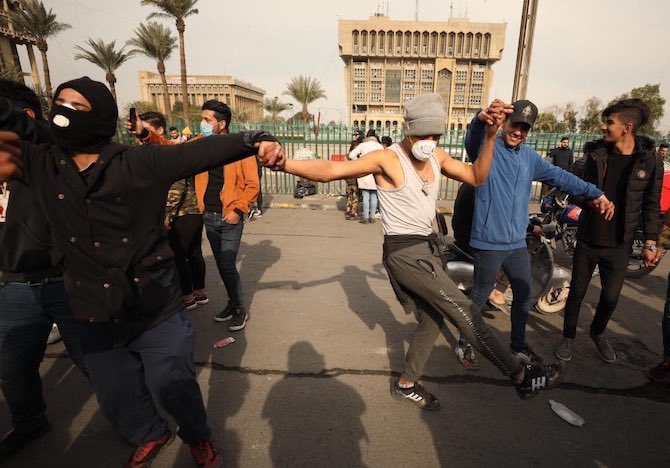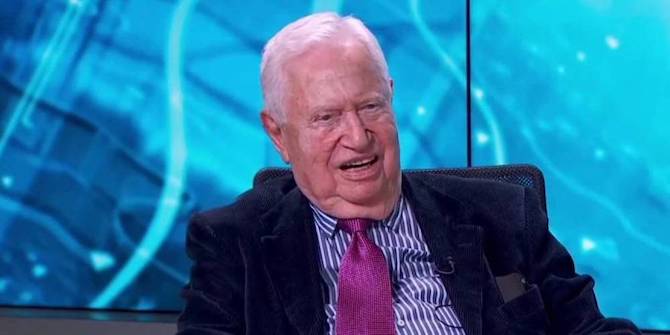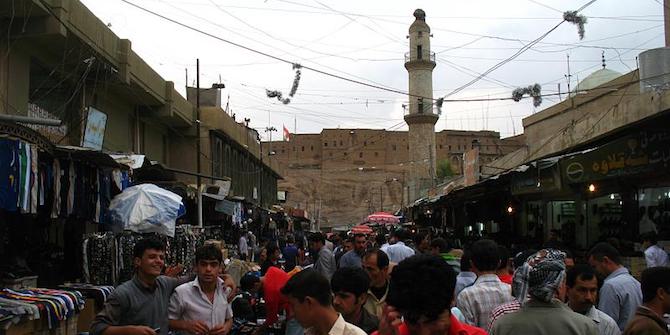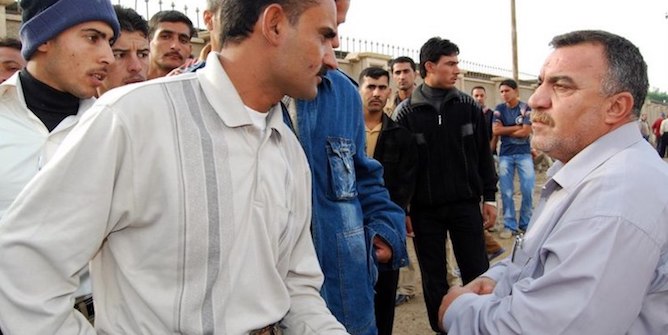by Hamzeh Al-Shadeedi, Mac Skelton & Zmkan Ali Saleem

Introduction
Amidst the sustained violence against Iraq’s protesters, the demonstrations have continued undeterred into their fifth month. In recent weeks, the protest movement has been forced to weather several tumultuous events. The American airstrike that killed Iranian General Qassem Soleimani and Iraqi Hashd al-Sha’abi (PMF) Leader Abu Mahdi al-Muhandis revived anti-American rhetoric in the mainstream political discourse, as most of the Shi’a political parties’ factions rallied around the Iranian regime. These factions saw this moment of solidarity among the Shi’a political class as an opportunity to overwhelm the protesters with both violence and rhetoric, ratcheting up patently false accusations that the demonstrations were carrying out American agendas in Iraq. Following the withdrawal of Muqtada Sadr’s supporters from the squares on 24 January 2020, security forces and militias seized this opportunity to attack protesters in Basra, Baghdad, Kut and Nasiriya. However, this violence was not enough to quash the demonstrators’ zeal. Within hours, people stormed the protest squares and reasserted the resolve of the movement.
A more recent blow came on 1 February, when Mohammed Tawfiq Allawi was designated to form the next cabinet. Allawi gained the nomination through yet another back-room political deal among powerful political blocs, thus ignoring the demand for an independent candidate. However, Allawi had no option but to withdraw his candidacy following a month of failed negotiations over cabinet picks. Allawi’s collapse indicates that muhassasah continues to be the guiding principle for government formation in Iraq. Yet it also displays the effectiveness of protesters’ pressure on the political elite.
Amidst these developments, violence against protesters in Najaf, Baghdad and Babil continued unabated. But, again, the demonstrations persevered. It has now become apparent that more deadly violence and threatening rhetoric will not send protesters home. Protesters’ resilience and commitment to their objectives have arguably been unmatched in Iraq’s modern history. To better understand the remarkable durability of the movement, IRIS reached out to 10 protesters and activists from several provinces (e.g., Baghdad, Najaf, Anbar), some of whom protested in the capital and others who took part in demonstrations in southern cities. The group included both everyday protesters as well as a few seasoned activists who had contributed to coordination and training efforts within the movement. We asked questions within three broad categories, inquiring about (1) the ideological and sociological composition of the movement; (2) the core demands and aspirations of the demonstrators; (3) and finally the leadership and coordination of the protests.
Their answers indicated the sociological complexity and the ideological diversity of within the protest movement; however, they also signalled broad agreement on several core demands which deserve serious analysis. Furthermore, while the movement has often been described as ‘leaderless’, this does not mean that it is formless and without any coordinating infrastructure. The Iraqi government will not be able to squash such a movement with brute force. Instead, political leaders should recognise that the power of the street is here to stay.
The Movement’s Composition
Yes, there are fissures among protesters. First, there are independents and those can be divided into many groups; promoters of a civil and secular state, or on the opposite end of the spectrum, there are those who fear secularism and wish to maintain an element of religiosity. There are peaceful protesters and those who want to express their resentments towards political parties and the government in violent means. Also, there are genuine protester, and those who go to the square for two hours to have fun and take pictures. The non-independent protesters are mostly Sadrists who follow their leader’s commands. Finally, there are intruders among protesters and these might be supported by militias or political parties.
– A prominent protester from Baghdad
When it comes to highlighting fissures within the protest movement, the media has mostly focused on the division between ‘independent’ protesters on the one hand and Sadrist demonstrators on the other. Some analysts forecasted the eventual implosion of the movement due to the severity of this clash. Our interviews indicated that the question of divisions must be understood in broader terms than a simple Sadrist/non-Sadrist distinction. Interviewees repeatedly pointed to the variety of political, religious, and ideological backgrounds of protesters – and how this diversity generated different political orientations. Protesters were very open about their disagreements on the personality of the interim prime minister, the extent of the reforms necessary to constitute success, and the ideological pillars of a sound and functioning Iraqi state. Some protesters explicitly called for a ‘secular’ and ‘civil’ state, while others showed a degree of discomfort in embracing these terms outright out of deference to religious authorities, and preferred to speak more generally about a state free from the dominance of corrupt political parties.
Far from seeing such distinctions as a threat to the durability of the movement, the protesters saw this diversity as a sign of its strength and legitimacy. They stressed the inclusiveness of the movement – one that represents Iraq’s complex society and not parochial agendas. This commitment to the notion of demographic and ideological diversity helps explain their repeated acknowledgement of the importance of Baghdad as a key symbol of the movement. One protester noted: ‘In Baghdad you find people from all the different social, religious, and sectarian classes including women.’ With such statements, the protesters implicitly rejected the common media refrain that the movement consists of a majority Shi’a populace revolting against a Shi’a dominated government. For the demonstrators, the rejection of identity political means that the sociological composition of the movement must also contain a wide cross-section of society to maintain its legitimacy.
As a sign of the movement’s embrace of different regional and ideological identities, each major city holds a slightly different symbolic weight in the discourse of protesters. While again Baghdad represents the movement’s diversity, other key protest hubs are seen as playing different but equally crucial roles. Najaf’s protesters insisted that their city is important not only because of Ayatollah al-Sistani (who has publicly defended the movement), but also because of the road map they formulated to resolve the political crisis, which has subsequently been adopted by all other provinces and includes most of the original Najafi demands. Meanwhile, Nasiriya’s protesters are regarded as the collective embodiment of the movement’s astonishing resilience in the face of violence. During the early days of the protests, they were subjected to extreme levels of brutality at the hands of the state, to which the protesters responded by remaining steadfast in the streets and burning down most of the political parties’ buildings. The revelation of the state crackdown in Nasiriya and the bold (albeit controversial) response from the street fundamentally redefined the relationship between people and the state at the national level. No longer would the existing government be regarded as possessing any last thread of legitimacy.
Despite the largely positive attitude towards ideological, regional, and sociological diversity, protesters did express concern that the small but notable clusters within the movement relying primarily upon violence were potentially threatening to its long-term sustainability. This concern is understandable considering that the protesters want to preserve legitimacy on the international stage. Furthermore, domestic anti-protest factions have used these isolated incidents of violence on their media and TV channels in order to taint the reputation of the broader movement. ‘Peaceful, peaceful’ can be understood not only as a slogan of the movement but also a rhetoric oriented towards side-lining extreme elements from within.

Demands & Aspirations
Initially, demands focused on providing basic services, ending corruption and achieving state monopoly of the use of weapons. But now, following months of harsh governmental crack-down, we ask for the whole reform of the political process in Iraq through an interim government that is willing to meet our demands, and prepare for a snap election with a new electoral law and under UN supervision.
– An activist from Najaf
Since the beginning of the demonstrations, Iraqi government officials and international analysts alike have consistently described the protesters’ demands as lacking in clarity and overly absolutist. Protesters were generally aware of this characterisation and firmly rejected its underlying premise, which is that protesters are the unreasonable party in the equation. Protesters explained to us that the intensity of their demands have increased in direct relation to the government’s deployment of violent force, repeated delays and purposeful obfuscations. One activist noted plainly: ‘The far-reaching demands for drastic change were a reaction to the government’s heavy use of violence.’ Another added: ‘Politicians do not think our demands are legitimate anyway and they will never work to deliver them. They have killed more than 600 of us so far. So you tell me, what is the point of having a dialogue with them?’ The protesters understand their absolutism as a reasonable response to the corruption and violence of the government, and not as an inherent or inevitable feature of the movement itself. Thus, one can infer the government’s continued usage of violence will only prolong the political impasse.
Our interviews indicate that the protesters’ demands are indeed far-reaching, but they fall short of the commonly alleged wholesale rejection of the system. Protesters want to change the occupants of the government but do not want to upend its core institutions and framework. They often invoked the Iraqi constitution to substantiate their positions. One said: ‘Our demands are clear and legitimate and they are enshrined in our constitution, but there is no political will to meet them as it threatens politicians’ authority and interests.’
Far from appearing incoherent or disorganised, protesters’ demands have cohered around three core categories: First, in the immediate term, they have repeatedly called for the resignation of the government and its replacement by an interim administration, which would be led by an independent prime minister charged with coordinating a snap election. Simultaneously, the resigned government should be held accountable for the violence against protesters through the appropriate judicial and legal channels. With the appointment and subsequent withdrawal of Mohammed Allawi as Prime Minister, the path forward on this set of demands remains unknown.
Secondly, two key sets of laws must be implemented towards the end of ceasing the reproduction of political elites and parties. First and foremost, they are firmly committed to the implementation of the new electoral law, which in theory would facilitate greater accountability through adopting smaller electoral districts and allowing independent candidates to run for election. Additionally, protesters we interviewed insisted that the enforcement of the longstanding political parties’ law would dramatically reduce the militarisation and corruption of the political system. The political parties’ law forbids parties from having armed wings, as well as receiving funds and support from foreign states. The law also requires political parties to be transparent on their sources of funding and finances.
Thirdly, in a related manner, interviewees stressed the need to dissolve militias and achieve state monopoly over the use and ownership of weapons; however, when asked how best to achieve this general vision, they were cautious and ambivalent in their responses. Most preferred not to comment on the specifics in great detail. This reticence should not come as a surprise given that armed state-backed militias as well as state security forces have repeatedly killed, intimidated and kidnapped activists and protesters who express opposition to the lawless behaviour and hegemony of these groups.
Leadership
The political elite is not looking for mediators to end the crisis and that’s why there are no mediators. They are looking for ways to preserve their gains and consolidate their power. As for Faiq Sheikh Ali he has been using populist rhetoric that complements our calls for change without using a threatening language. Al-Sistani’s sermons, unfortunately, do not have any real effect anymore because politicians pick and choose what they want to hear from his speeches are they rarely listen to him if his advice threatens their interests.
– A political science student protesting in Baghdad
While the movement has often been heralded as ‘leaderless’ and without any official negotiations with the state, our interviews indicate that this depiction requires a fair amount of nuance. In the discourse of protesters, there is often a difference between their mostly negative rhetoric around the notion of having leaders in the sense of political representatives on the one hand, and their acknowledgment of the coordinating functions and ideological influence of certain key organisations and figures on the other. In short, the movement is neither entirely devoid of organisational structures nor is it entirely lacking in important personalities.
Protesters openly and enthusiastically acknowledge the role played by independent civil society organisations (CSOs) and professional unions. Activists told us that these CSOs support the movement through organising workshops and lectures (e.g. to explain constitutional frameworks and relevant laws, to provide practical skills for organising campaigns). These activities have substantively shaped protesters demands – ensuring that they are rooted in plausible constitutional and legal precedents. They have also contributed to the complex logistics of maintaining a mass movement (such as providing basic medicine, lavatories and water supplies), in addition to ensuring that the demonstrations remain committed to non-violence. In addition to CSOs, protesters highlighted the crucial role of the loose networks of doctors, nurses and ambulance drivers, who have coordinated the provision of healthcare despite running the risk of losing their jobs.
When protesters insist that there are no ‘leaders’ of their movement, one could interpret this statement as signalling a new understanding of leadership, one that departs from the model typically witnessed in the Iraqi context. In Iraq, leaders – be they politicians, sheikhs or other figures – are conceived as self-oriented individuals working to increase wealth and influence at the expense of the people. Iraqis have been betrayed repeatedly by leaders who rose to power through their support, only to cash in as soon as they entered office. Iraq’s protests rely upon key organisations and acknowledges the role of certain figures, but they exemplify a different kind of leadership: they are risking their lives and wellbeing to shape, coordinate and direct a movement that serves the greater good, not themselves.
However, this rejection of the standard model of leadership in Iraq does not mean that they are necessarily absolutist in their stance on non-engagement with the existing political class. When we put the question of whether any of their members had undertaken negotiations with the government or established any alliances within the state, they typically answered us with a firm ‘no’ at the outset. One protester asserted that any ‘independent protesters would not communicate with an illegitimate, corrupt and murderous government,’ adding that ‘previous negotiations have proved meaningless and worthless.’ However, certain protesters seem to accept alliances or at least engagement with political and religious leaders who show sympathy towards their side and further their interests. For example, a protester from Baghdad stated that a few key activists from Tahrir met with President Barham Salih. The President won the tentative trust of portions of the movement through his supportive rhetoric and, more importantly, his refusal to nominate a prime minister who is not accepted by protesters. However, this willingness to engage with Salih is by no means assured. During one meeting with Salih, protesters reiterated their positions and warned him that they would demand his resignation were he not to nominate a favourable prime minister soon. With Allawi’s designation and ultimate withdrawal, it is unclear whether the protesters will re-engage with Salih in the process of choosing another candidate for the premiership.
As for religious authorities, protesters have expressed appreciation for Ayatollah al-Sistani’s supportive calls. Al-Sistani has been on the side of the popular protests since they began, they maintain. But they have voiced their disappointment on how politicians choose to respond to al-Sistani’s sermons. A protester from Baghdad noted that ‘politicians pick and choose what they want to hear from al-Sistani’s sermons, and they never work according to his advice if it contradicts with their interests.’
Conclusion
The Iraqi protest movement has proven durable amidst great pressures. While the movement contains number of ideological fissures with a variety of viewpoints on key issues (including on leadership, the transitional government, and the long-term vision of what a truly civil and democratic Iraqi state should look like), there is a remarkable degree of coherence around the core goal of definitively ending the continual reproduction of the current political class. This is why all protesters agree on the importance of implementing the election and political party laws. The outright disgust towards the political class has been solidified in the violent reaction of the state, through which state actors proved their illegitimacy. Yet the protesters are not rigid. The entrenched rejectionism of the political class contrasts with the strategic flexibility of the protesters, who have been cautiously willing to accept cooperation with establishment figures when it serves their interests. For these reasons the movement has endured into its fifth month.
With Mohammed Allawi’s recent withdrawal of his candidacy for the post of Prime Minister, the movement enters a new stage and must decide whether or not to re-engage with the political elite to influence their next choice for premiership. One thing is certain: continued violence will not push the protesters closer to engaging in negotiations with the administration. The violence of Ministry of Defence forces, the PMF, and most recently the Sadrists has and will continue to harden the position of the protesters against the ruling parties and deepen their distrust of Iraqi authorities.
This piece was co-published with the Institute of Regional and International Studies (IRIS) at the American University of Iraq Sulaimani (AUIS).






